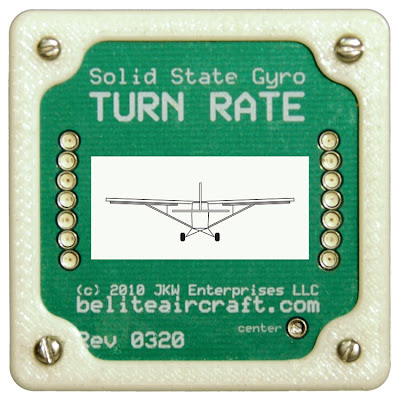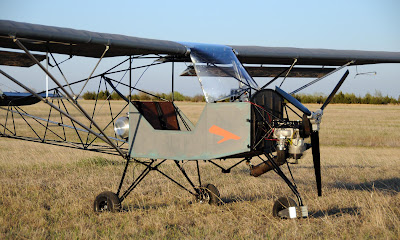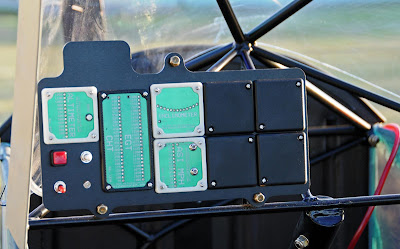
Gene and I have made several panels for a variety of our aircraft. They were a mixture of basic instruments: airspeed indicators, altimeter, engine gauges, inclinometers. Basic stuff.
I'd run into a few problems with instruments breaking; also a few problems with inaccuracies. I was tired of weight. I started to think about ways to improve that panel. My 30 years of experience in electronics kept nagging me: I just had to develop some good, inexpensive, state of the art instruments.
A lot of very good companies produce fantastic, expensive stuff. Almost all of the direction of the industry has been towards more integration and more expense.
Why not break that trend?
Why not design basic electronic instruments that replace old fashioned steam stuff, that cost less, that works better, that weigh about a dozen grams, not a dozen ounces or even one or two pounds, and that more quickly alerts (using bright LEDS) to marginal conditions such as low fuel or redline speed? How about instruments with no dials to twist?
Well, that's what I did.
We introduced 10 new instruments to the market. I won't pick at the details of each here (see our
avionics page for details). I'll just mention the key points of one of them.
.jpg)
Let's talk about our Turn Rate Indicator:
1) It truly has a solid state gyro in it, and it's incredibly sensitive.
2) It's designed to show a standard rate turn. And several other turn rates.
3) It uses different colored LEDS to quickly show when a turn has begun.
4) The LEDs are bright, easily observed in a bright cockpit.
5) You can see them with sunglasses on, even polarized sunglasses (unlike many LCD screens.)
6) And unlike mechanical gyros, it's inexpensive (about $150).
7) And also unlike mechanical gyros, you can buy it in a tiny box (3 x 2 x 1 inch) which you can velcro to any panel. It runs off an enclosed 9v battery for about 14 hours.
8) Or you can buy it with a standard 2 1/4 inch cutout bezel.
9) Or you can buy it with an even smaller 1.75 inch square bezel.
This is how we approached the design of each of our instruments: Lots of installation and use options, bright LEDs, simple operation, really low costs. Great for experimental, homebuilt, patch flying, ultralights, and perhaps a few other markets as well. (Helicopters? Yes. Gliders? Absolutely.)
My daughter Jennifer prepared a great video demonstrating the Turn Rate Indicator. You can see the
video here. If that doesn't work, go to
belite's channel on youtube and you'll find several more of our avionic and flying videos.
Even though the concepts are simple, the electronic technology has been a tough at times to tackle. In order to protect the work that has been done, we recently filed 9 patent applications on our technology. As a result, our designs are 'patent pending', which is a great thing as well.
The entire instrument panel pictured at the beginning of this post weighs about 12 ounces. That includes the basic metal plate, and all of the instruments. This is one of the developments that continues to ensure that our aircraft are the best and that our avionics (and aircraft) customers have the easiest to use, lightest, least expensive and most comprehensive goodies in the cockpit.
I appreciate your feedback. I was given several great ideas for additions to this new product line at Sun N Fun -- we'll work on some of them and hopefully show even more avionics at Oshkosh. In the meantime, this is great new stuff.
Finally, these avionics are 'on sale' for this first week of their introduction. You can order them with discount code SUN10 on our webstore through the end of 2010 Sun N Fun, (april 18) and this will give you a 20% discount!
We are also intent on adding distributors, both here in the US and overseas. Interested? Let me know.



.jpg)

